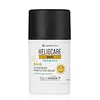What's inside
What's inside
 Key Ingredients
Key Ingredients

 Benefits
Benefits

 Concerns
Concerns

 Ingredients Side-by-side
Ingredients Side-by-side

Coco-Caprylate/Caprate
EmollientDicaprylyl Carbonate
EmollientBis-Ethylhexyloxyphenol Methoxyphenyl Triazine
Skin ConditioningDiethylamino Hydroxybenzoyl Hexyl Benzoate
UV FilterDibutyl Lauroyl Glutamide
Skin ConditioningDiethylhexyl Butamido Triazone
UV AbsorberEthylhexyl Triazone
UV AbsorberDibutyl Ethylhexanoyl Glutamide
Skin ConditioningEthyl Vanillin
MaskingPolypodium Leucotomos Leaf Extract
Skin ProtectingTocopherol
AntioxidantDiethylhexyl Syringylidenemalonate
Skin ProtectingCaprylic/Capric Triglyceride
MaskingHaematococcus Pluvialis Extract
AntioxidantPropylene Glycol
HumectantMaltodextrin
AbsorbentLecithin
EmollientSilica
AbrasiveAscorbyl Palmitate
AntioxidantRosmarinus Officinalis Flower/Leaf/Stem Extract
MaskingCoco-Caprylate/Caprate, Dicaprylyl Carbonate, Bis-Ethylhexyloxyphenol Methoxyphenyl Triazine, Diethylamino Hydroxybenzoyl Hexyl Benzoate, Dibutyl Lauroyl Glutamide, Diethylhexyl Butamido Triazone, Ethylhexyl Triazone, Dibutyl Ethylhexanoyl Glutamide, Ethyl Vanillin, Polypodium Leucotomos Leaf Extract, Tocopherol, Diethylhexyl Syringylidenemalonate, Caprylic/Capric Triglyceride, Haematococcus Pluvialis Extract, Propylene Glycol, Maltodextrin, Lecithin, Silica, Ascorbyl Palmitate, Rosmarinus Officinalis Flower/Leaf/Stem Extract
Water
Skin ConditioningC12-15 Alkyl Benzoate
AntimicrobialDimethicone
EmollientIsododecane
EmollientTitanium Dioxide
Cosmetic ColorantZinc Oxide
Cosmetic ColorantButyloctyl Salicylate
Skin ConditioningSodium Potassium Aluminum Silicate
Niacinamide
SmoothingAlumina
AbrasiveStyrene/Acrylates Copolymer
Phenethyl Benzoate
EmollientPEG-9 Polydimethylsiloxyethyl Dimethicone
EmulsifyingPolypodium Leucotomos Leaf Extract
Skin ProtectingPhysalis Angulata Extract
Skin ProtectingMelanin
Skin ProtectingPlankton Extract
Skin Conditioning3-O-Ethyl Ascorbic Acid
Skin ConditioningOxothiazolidine
Skin ProtectingTocopheryl Acetate
AntioxidantHydrogen Dimethicone
Phenylpropanol
MaskingPolyhydroxystearic Acid
EmulsifyingMagnesium Sulfate
Dimethicone/PEG-10/15 Crosspolymer
Propylene Glycol
HumectantCaprylyl Glycol
EmollientSilica
AbrasivePropanediol
SolventTriethoxycaprylylsilane
Caprylic/Capric Triglyceride
MaskingTocopherol
AntioxidantButylene Glycol
HumectantDipropylene Glycol
HumectantSodium Citrate
BufferingDisteardimonium Hectorite
StabilisingPropylene Carbonate
SolventLecithin
EmollientPhenoxyethanol
PreservativeSodium Benzoate
MaskingWater, C12-15 Alkyl Benzoate, Dimethicone, Isododecane, Titanium Dioxide, Zinc Oxide, Butyloctyl Salicylate, Sodium Potassium Aluminum Silicate, Niacinamide, Alumina, Styrene/Acrylates Copolymer, Phenethyl Benzoate, PEG-9 Polydimethylsiloxyethyl Dimethicone, Polypodium Leucotomos Leaf Extract, Physalis Angulata Extract, Melanin, Plankton Extract, 3-O-Ethyl Ascorbic Acid, Oxothiazolidine, Tocopheryl Acetate, Hydrogen Dimethicone, Phenylpropanol, Polyhydroxystearic Acid, Magnesium Sulfate, Dimethicone/PEG-10/15 Crosspolymer, Propylene Glycol, Caprylyl Glycol, Silica, Propanediol, Triethoxycaprylylsilane, Caprylic/Capric Triglyceride, Tocopherol, Butylene Glycol, Dipropylene Glycol, Sodium Citrate, Disteardimonium Hectorite, Propylene Carbonate, Lecithin, Phenoxyethanol, Sodium Benzoate
 Reviews
Reviews

Ingredients Explained
These ingredients are found in both products.
Ingredients higher up in an ingredient list are typically present in a larger amount.
This ingredient is an emollient, solvent, and texture enhancer. It is considered a skin-softener by helping the skin prevent moisture loss.
It helps thicken a product's formula and makes it easier to spread by dissolving clumping compounds.
Caprylic Triglyceride is made by combining glycerin with coconut oil, forming a clear liquid.
While there is an assumption Caprylic Triglyceride can clog pores due to it being derived from coconut oil, there is no research supporting this.
Learn more about Caprylic/Capric TriglycerideLecithin is a term for a group of substances found in the cell membranes of plants, animals, and humans. They are made up of mixture of phospholipids.
This ingredient has emollient and emulsifying properties.
As an emollient, lecithen helps soften the skin and creates a barrier to keep moisture in.
As an emulsifier, it also helps prevent water and oil ingredients from separating. Lecithin can also help ingredients be better absorbed by the skin.
This is because the phospholipids in lecithin produce liposomes. Liposomes help other ingredients get through the skin barrier.
Depending on the source of this ingredient, lecithin may not be fungal acne safe. This is because some sources of lecithin come from soybean oil, which may feed the malassezia yeast that feeds fungal acne.
We recommend reaching out to the brand you are purchasing from to inquire about the source of their lecithin.
Some other names for this ingredient include soy lecithin and deoiled soy lecithin.
Learn more about LecithinWe don't have a description for Polypodium Leucotomos Leaf Extract yet.
Propylene Glycol is an odorless, colorless liquid. As a humectant, it helps skin retain moisture. It also aids in delivering active ingredients.
Another role of this ingredient is preventing a product from melting or freezing. Propylene glycol also adds antimicrobrial properties to a product, elongating product lifespan.
This ingredient is considered an organic alcohol and commonly added into both cosmetics and foods.
Those with sensitive skin or conditions may develop a rash when using this ingredient.
Learn more about Propylene GlycolSilica, also known as silicon dioxide, is a naturally occurring mineral. It is used as a fine, spherical, and porous powder in cosmetics.
Though it has exfoliant properties, the function of silica varies depending on the product.
The unique structure of silica enhances the spreadability and adds smoothness, making it a great texture enhancer.
It is also used as an active carrier, emulsifier, and mattifier due to its ability to absorb excess oil.
In some products, tiny microneedles called spicules are made from silica or hydrolyzed sponge. When you rub them in, they lightly polish away dead skin layers and enhance the penetration of active ingredients.
Learn more about SilicaTocopherol (also known as Vitamin E) is a common antioxidant used to help protect the skin from free-radicals and strengthen the skin barrier. It's also fat soluble - this means our skin is great at absorbing it.
Vitamin E also helps keep your natural skin lipids healthy. Your lipid skin barrier naturally consists of lipids, ceramides, and fatty acids. Vitamin E offers extra protection for your skin’s lipid barrier, keeping your skin healthy and nourished.
Another benefit is a bit of UV protection. Vitamin E helps reduce the damage caused by UVB rays. (It should not replace your sunscreen). Combining it with Vitamin C can decrease sunburned cells and hyperpigmentation after UV exposure.
You might have noticed Vitamin E + C often paired together. This is because it is great at stabilizing Vitamin C. Using the two together helps increase the effectiveness of both ingredients.
There are often claims that Vitamin E can reduce/prevent scarring, but these claims haven't been confirmed by scientific research.
Learn more about Tocopherol